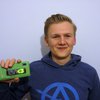Challenge: making PCBs yourself quickly & easily
Take the 3 major phases of making electronics; schematic design, PCB manufacturing and assembly, and try to optimize the process. Assuming you download a .kicad_pcb and has all the parts in a drawer to hand assemble, the longest phase becomes getting the PCB made.
Getting a PCB made can either be affordable or fast, but not both. Quick turn runs cost a lot of money and may not be available in all regions. In the last few years cheaper alternatives have popped up like buying direct from China or batched paneling from oshpark.com (<3 Oshpark!), and while such low-cost options have allowed for a more rapid iteration process, getting them can still take weeks depending on where you live and the customs policy of your country.
Etching is an affordable and low-cost process people have been using for years, but it has it's downsides, which is why many people choose to not etch their own PCBs. The process is finicky, requiring multiple imprecise steps that take many iterations of trial-and-error to perfect. The chemicals used stain everything and are caustic, which means they can't be used in education with kids. Further, those caustic chemicals need to be disposed of at appropriate facilities, which is at best, a hassle. And given all that complexity, most people never bother to add solder masks or silkscreens, the first being critical for working with SMD parts and the latter for sharing with other makers.
Milling machines can also be used to make traces and pads on copper clad. These are great for larger components, but require the highest-end mills to create fine pitch traces or BGAs pads.
There is also a crop of machines trying to use fused deposition modeling (FDM) to lay effectively conductive filament (usually silver-based) on top of a substrate. Like milling, FDM machines have lower resolution and the price of silver continues to go up, raising the recurring cost of consumables.
Solution: automate etching, solder masking and silkscreening
etchr is a desktop-sized machine that takes the best elements of etching PCBs while reducing the pain points described above. The main features of etchr include:
- Automated application of chemicals so you never have to touch them
- High-fidelity and repeatability using the latest in low-cost Stereolithography (SLA)
- Eco-friendly chemicals that are nearly as effective as the alternatives... because science (well, smarter chemical processes.)
etchr has 5 main functional areas:
- A UV projector that creates the exposure areas of the board, solder mask and silkscreen layers
- A pump and spraying system to apply the chemicals to the workpiece
- Reservoirs for the various UV-sensitive chemicals and rinses to be applied
- Overflow vat to collect excess chemicals
- Electronics to control the projector and pump system
The ultimate goal of etchr is to approach the fidelity of services like Oshpark, with 6 mil trace clearance & trace width, BGA footprints, etc. and even multi-layer boards (someday.) You need crawl before you walk so for the #2017hackadayprize, the first milestone is to print a single-sided board (double-sided is a stretch goal.)
Changing the world: access, S.T.E.A.M. & the environment
Access
Those of us in the US take for granted the fact that we have access to low-cost PCBs with a less-than two week arrival time. Folks in other countries, either due to being far from the East or West or having a slow customs process, do not have that luxury. As an example, a sample lowest price on pcbshopper.com for a 150x75mm PCB (minimum 5 qty) is $36.32 with a 43 day lead-time. A machine like etchr could provide makers around the world quick and low-cost access to the PCBs they need to learn, teach and create businesses.
S.T.E.A.M.
etchr would provide students and educators with a fast tool to learn and iterate while ensuring safety for even the youngest makers.
The Environment
There are many different chemicals and processes that can be used to etch PCBs. The more caustic varieties tend...
Read more » Jonathan Beri
Jonathan Beri

This sounds great! I hope you'll get to the point where our hackerspace will be able to afford one =)